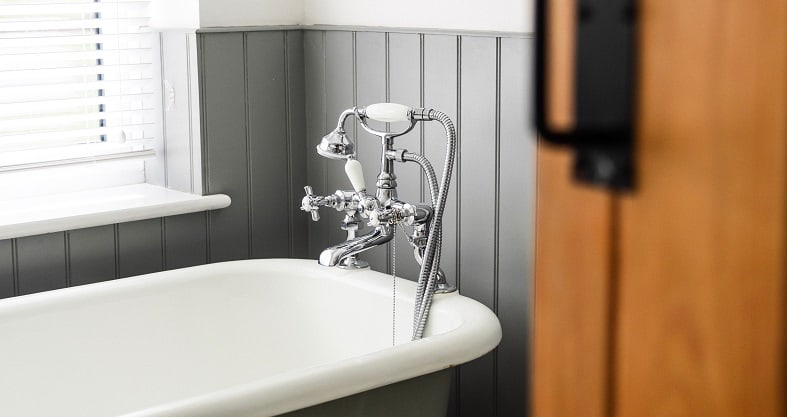- Making the Most of Your Smart Home: Common Use Cases - March 28, 2023
- Eco Mode at Night: Maximizing Nest’s Energy Savings - March 20, 2023
- Connecting & Controlling Smart Home Devices: A Guide - March 18, 2023
Disclosure: Links marked with * are Affiliate Links. As an Amazon Associate, I earn from qualifying purchases if you decide to make a purchase through these links – at no cost for you!
Most household fires occur in the kitchen. Defective electrical appliances, oil that is too hot or people forget to turn off the stove. But fires also frequently start in the bathroom.
Three to four deep breaths alone are enough for the dense clouds of smoke to reach the lungs and damage them. Victims of smoke poisoning often lose consciousness and thus have no way of warning their family and saving themselves.
The numbers are frightening, but you can reduce the risk of smoke poisoning and fire accidents by taking precautions.
If you choose a smoke or heat detector, you will be warned soon enough.
Smoke and heat detectors sound the alarm immediately if, for example, smoke is produced due to a fallen candle or a burning cigarette and the temperature rises dramatically.
But which smoke detectors are most reliable even in rooms with high humidity? Heat detectors are best, as steam can lead to false alarms with conventional smoke detectors. We can clearly recommend the Nest Protect*, which can distinguish between steam and smoke as well as carbon monoxide.
Here you can take a closer look at the Nest Protect on Amazon: Link*
Table of Contents
What is the Difference between a Smoke Detector and a Heat Detector?
Smoke detectors are able to detect smoke developments at an early stage. They emit a loud alarm tone and warn the residents of the impending danger.
You gain valuable seconds, you may be able to warn your roommates and you can keep yourself and your family safe.
Although smoke detectors are ideal for living areas, they are less recommended for humid rooms. Heat detectors are recommended for areas with high humidity, as they do not trigger an alarm when water vapor develops!
Heat detectors are able to detect fires on the basis of the rapidly rising temperature. This warning system is ideal for kitchens and bathrooms. In addition, these lifesavers are also suitable for areas where a lot of dust and steam is generated. Workshops, kitchens and bathrooms should be equipped with a heat detector instead of a smoke detector, as smoke detectors often give a false alarm in these kinds of environments.
Heat detectors belong to the fire detectors and they are also called thermal detectors. In contrast to smoke detectors, they do not react to smoke, but to the drastically increased room temperature.
These special devices are equipped with an integrated thermometer, which continuously measures the room temperature. If the room temperature rises above 130 or 140 degrees Fahrenheit, the heat detector sounds an alarm in the form of an acoustic signal.
Buying Criteria
If you consider the following criteria before buying, you will get a device that is safe, of high quality, durable and worth its money!
Power Supply
You have the choice of three power supply options.
Lithium-ion Battery
Modern models are equipped with a lithium-ion battery. Heat detectors with this long-life battery are currently among the most frequently sold devices.
Although you will need to replace the thermal detector with a lithium-ion battery with a new model when the battery runs out, the built-in sensors have a limited life and will need to be replaced after about ten years anyway.
Thermal detectors with integrated rechargeable batteries are not only durable but also maintenance-free with a service life of around ten years.
Battery Operation
Battery-powered devices are cheaper, but you have to replace the batteries after two years at the latest.
The advantage is that you can get these batteries in any supermarket, but battery-powered smoke detectors also have some notable disadvantages.
The battery has a limited lifetime and does not last nearly as long as a lithium-ion battery. So you have to maintain your thermal detector every year.
The purchase of these new batteries will cost money over the years. There is also the danger that you forget to equip your heat detector with new batteries.
Power Cord
Alternatively, heat detectors that are operated by power cable are an alternative. Models of this type are suitable for commercial use to ensure that a permanent power supply is guaranteed.
Thermal detectors of this type are rather the exception for private consumers. The disadvantage is that you have to position the thermal detector close to a power outlet and the cable is not exactly an eye-catcher.
Radio Networking for Houses and Large Apartments
Fire detectors that are installed in the same room where you sleep cannot be ignored because of the glaring beep.
However, if your heat detector is located on another floor of your house or at the end of the hall in the bathroom or kitchen, there is a risk that you will overhear the alarm during your night’s rest.
If you live in a house or a large apartment, you should establish a network between other fire detectors and your heat detector.
Alarm systems that are linked to each other are recommended. Only then can you be sure that you hear the alarm signal in every room and can get yourself and your family to safety before the fire spreads throughout the entire apartment and there is no escape route.
Assembly/Installation
To avoid having to order a specialist, you should choose a model that is easy to assemble.
The classic mounting is done with two screws that you attach to the ceiling. Both the screws and the plugs are included in the delivery.
Screw the so-called foot of your heat detector firmly to the ceiling. Afterward, you can anchor the corpus including the sensor by a turning movement.
If you choose a heat detector with a lithium-ion battery, you activate the lifesaver by screwing it into the ceiling.
For some years now, thermal detectors with magnetic holders have also been on the market, which are easy to install. The magnet set is supplied with two metal discs, both with an adhesive surface. Glue one metal disc to the ceiling, while you glue the other disc to the base of the heat or smoke detector.
It is not necessary to detach the foot from the body. If you hold the heat detector against the ceiling, it will stick to the magnetic discs.
It is advantageous that no hole has to be drilled for models with magnetic system. It should also be emphasized that you can install the heat detector quickly and that no dirt is left behind during installation.
A downer of magnetic adhesives is that the magnetic disk sticks extremely well to the ceiling and you have to use force to remove it. It is not uncommon for the plaster to break off when removing it.
In the meantime, many manufacturers advise not to remove the pane adhering to the ceiling, but to simply apply wall paint on top of it.
You can purchase the magnetic attachment separately.
Button for Operation
For easy operation of your heat detector, you should choose a model with a large button. Unfortunately, the button for muting and testing is very small and cannot be operated with a broom handle, for example.
Especially in case of a false alarm, a large button pays off to switch off the falsely activated alarm as quickly as possible.
Find out in current tests and customer reviews whether the button is big enough.
Position of the Button
To ensure that you can operate the button quickly and easily, it should be placed within easy reach. Remember that the heat detector is fixed to the ceiling and you will need to operate it with a broomstick or stick unless you put up a ladder.

Smoke Detector or Heat Detector for the Kitchen?
If you equip your kitchen with a fire detector, you should choose a model that only measures the temperature.
Do not use a fire detector that measures smoke particles. The reason for this is that steam is produced during cooking and thus false alarms are triggered.
There are kitchen smoke detectors suitable for use in the kitchen on the market, which are characterized by a special design. Characteristic is the specially designed measuring chamber, which measures not only the smoke but also the heat. This ensures that the alarm is only triggered in case of concrete signs of a fire.
Alternatively, a heat detector is advisable in the kitchen, which only measures the rise in temperature but does not go off when steam is generated.

Why are Heat Detectors useful in the Kitchen?
In no other place in the home do so many fires occur as in the kitchen. 39 percent of all fires investigated originate in the kitchen and therefore a heat detector is recommended.
Besides electronic defects, most kitchen fires are due to human error. If you forget to turn off the stove or if oil gets too hot, a fire can start. A thermal detector can warn you and your family!
Smoke Detector with Mute Function
Some manufacturers describe a smoke detector that is equipped with a mute function as suitable for kitchen use.
Note, however, that the test button must be pressed for this. This means that you have to press this button manually each time before cooking. False alarms are not uncommon if you forget to press the test button.
In addition, the sensors of these models suffer because they are not designed for the vapors normally found in the kitchen.
It is therefore not advisable to use appliances with mute function in the kitchen.
Smoke Detector or Heat Detector for the Bathroom?
Just as in the kitchen, only fire detectors that only sound the alarm at an increased temperature are recommended.
When showering or bathing, water vapor forms, which can lead to false alarms if the fire detector measures smoke particles.
It is recommended to install a thermal detector or a smoke and carbon monoxide detector in the bathroom!
The smoke and carbon monoxide detector Nest Protect* is particularly recommended.
The second generation of this branded product is characterized by several sensors that detect and differentiate between hazards such as carbon monoxide and smoke. To minimize false alarms, this model features steam detection.
The integrated humidity sensor detects water vapor and analyses it using special algorithms. An advantage is that this innovative smoke detector is able to detect carbon monoxide. As a result, you can even use this model in a bathroom with a water heater or gas boiler.
What are the Advantages and Disadvantages of a mixed Detector?
Mixed detectors respond to both heat and smoke and combine the functions of heat and smoke detectors.
Although this variant is particularly reliable because the measurement is performed twice, models of this type are not suitable for kitchens, bathrooms and the workshop.
Attention: When installing electronic equipment, please be sure to observe the manufacturer’s safety instructions. You have to take care of your own safety. The information on this site only helps you to learn.
Disclosure: This website is the property of Martin Lütkemeyer and is operated by Martin Lütkemeyer. Martin Lütkemeyer is a member of the Amazon Services LLC Affiliate Program, an affiliate advertising program designed to enable Web sites to earn advertising revenue through advertising and linking to Amazon.com. Links marked with * are affiliate links.

